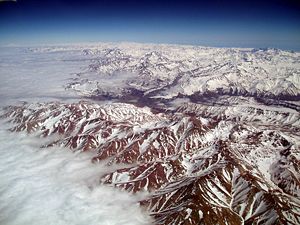South America

South America is the continent to the south of North America.[1][2] These two continents are separated by the Panama Canal. There are seven continents which make up the globe, South America being the 4th largest. South America includes 14 countries: Argentina, Bolivia, Brazil, Chile, Colombia, Ecuador, Falkland Islands (United Kingdom), French Guiana (France), Guyana, Paraguay, Peru, Suriname, Uruguay and Venezuela.
South America is attached to Central America at the boundary of Panama.[3] Geographically[4] all of Panama – including the part east of the Panama Canal is usually included in North America alone,[5][6][7] among the countries of Central America.[8][9]
List of Countries[edit]
 Argentina
Argentina Bolivia
Bolivia Brazil
Brazil Chile
Chile Colombia
Colombia Ecuador
Ecuador Falkland Islands
Falkland Islands- Template:Country data French Guiana
 Guyana
Guyana Peru
Peru Paraguay
Paraguay Suriname
Suriname Uruguay
Uruguay Venezuela
Venezuela
Natural resources[edit]
The soil in Argentina's Pampas is among the best in the world. Brazil's soil is very good for growing coffee.[3] A great number of minerals have been found. Few, however, have been mined.[3] Among those that were mined are iron, manganese, gold, and gemstones.[3] The tropical forests are rich in valuable trees, like mahogany, ebony, and rubber.[3] Oil is also a resource in some places.[3]
Wildlife[edit]
South America is home to a large variety of animal life. These include animals such as jaguars, macaws, monkeys, anacondas, llamas, piranhas, toucans, tapirs, cougars, condors and chinchillas.
Tourist attractions[edit]
The most popular attractions are:
- Machu Picchu, a historic site in Peru which is a city made of stone and has a over 26 mile marathon.
- The Iguazu Falls, a waterfall on the border between Argentina and Brazil
- The Angel Falls, the world's tallest waterfall, in Venezuela
- Rio de Janeiro and its carnival in Brazil is a huge seaside city in Brazil, famed for its Copacabana and Ipanema beaches, 38m Christ the Redeemer statue atop Mount Corcovado and for Sugarloaf Mountain, a granite peak with cable cars to its summit. The city is also known for its sprawling favelas (shanty towns). Its raucous Carnaval festival, featuring parade floats, flamboyant costumes and samba dancers, is considered the world’s largest.
- The Patagonia region in Argentina and Chile
- The Christ Redeemer in Brazil, a large, white statue of Jesus Christ.
See also[edit]
The Amazon rain forest[edit]
The amazon rain forest is a moist grassy land where many wild animals live and contains the amazon river which is the 2nd longest river in the world and has the largest volume of water. The world's longest river is the Nile in Africa. The forest is known as a rain forest as it rains very often but due to the dense surroundings not every droplet reaches the bottom. The Amazon is shared by eight countries (Brazil, Bolivia, Peru, Ecuador, Colombia, Venezuela, Guyana and Suriname) and stretches for 6.7 million kilometers2. In the amazon rain forest, hundreds of thousands of trees have been cut down for wood and paper, meaning that the forest is endangered. Unlike the Boreial forest in Canada the trees are not getting replanted.
References[edit]
- ↑ "South America Archived 2009-02-10 at the Wayback Machine. ', 6th ed. 2001–6. New York, Columbia University Press": "fourth largest continent ..., the southern of the two continents of the Western Hemisphere." Archived from the original Archived 2009-02-10 at the Wayback Machine 2009-02-10. Retrieved 2017-03-24
- ↑ "Countries in Latin America & the Caribbean". lanic.utexas.edu. Retrieved 6 April 2010.
- ↑ 3.0 3.1 3.2 3.3 3.4 3.5 Koontz, Terri; Mark Sidwell, S.M.Bunke (June 2005). World Studies. Greenville, South Carolina 29614: Bob Jones University Press. ISBN 1-59166-431-4.
{{cite book}}: CS1 maint: location (link) - ↑ Cohen, Saul Bernard. 2003. "North and Middle America" (Ch. 5). Geopolitics of the World System (ISBN 0847699072)
- ↑ "Americas" Standard Country and Area Codes Classifications (M49), United Nations Statistics Division
- ↑ "The Atlas of Canada - North America". atlas.nrcan.gc.ca. Archived from the original on 21 October 2006. Retrieved 6 April 2010.
- ↑ "Atlas - Xpeditions @ nationalgeographic.com". nationalgeographic.com. Retrieved 6 April 2010.
- ↑ "Panama". Britannica Concise Encyclopedia
- ↑ Geography: Panama Archived 2020-05-09 at the Wayback Machine CIA World Factbook 2008.